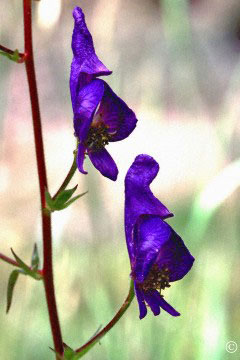 |
The Western monks-hood, Aconitum
columbianum Nutt. (left) is the only species of monkshood
native to the Northwest. It flowers in midsummer in wet meadows, seep-springs,
and along stream banks at mid- to high elevations. Deep purple flowers are
spaced along the top of a tall stem. The “hood” is a petal-like
sepal that encloses two small petals. All parts of the plants are poisonous.
Criminals were executed and wolves were poisoned with a distillate from
Aconitum lycoctonum, the European wolf’s-bane. Although the
monkshood’s flowers, like those of the related larkspur, are almost
always purple, occasionally albino forms turn up (right). |
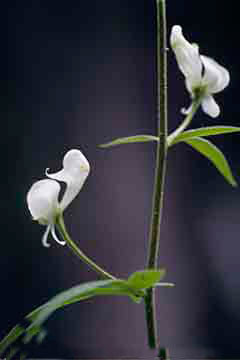 |
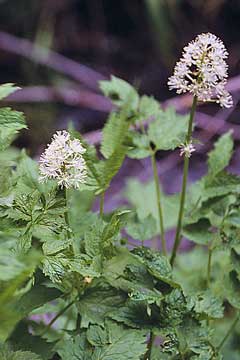 |
Red baneberry, Actaea
rubra (Ait.) Willd.
(left, right) grows in all of the northern states and
provinces, along the banks of shaded streams. Short-lived white flowers form
tight clusters. The shrub’s red (occasionally white) berries are poisonous.
Actaea, from the Greek means elderberry as our plant’s leaflets
apparently resemble the leaves of a European elder. The name rubra
means “red” for the berries. The common name is derived from the
Old English word “bane,” a word that means
“poison.” |
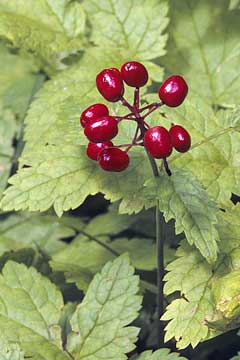 |
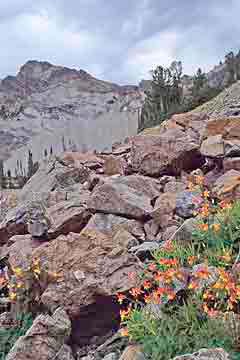 |
Sitka columbine, Aquilegia formosa
Fisch. ex DC. (left, right). The Sitka (also red,
or crimson) columbine is tall, with distinctive three-parted leaves, its
sepals vary in color from pale orange to bright red, depending on growth
conditions. These are set off by five, red-based, yellow petals and many
long yellow anthers. The plants flower from late spring through mid-summer,
as high as treeline. The scientific name Aquilegia was derived from
the Latin word acquila meaning “eagle,” because the
flower’s five spurs were thought to resemble an eagle’s claws.
The species name, formosa, also from the Latin, means
“beautiful.” Paradoxically—given the derivation of the generic
name—“columbine” means “dove-like” because the spurs
in some species are said to be shaped like the head and neck of a dove.
|
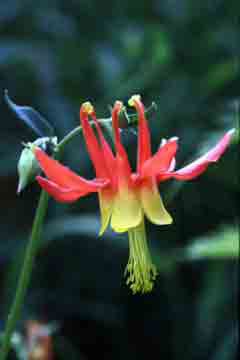 |
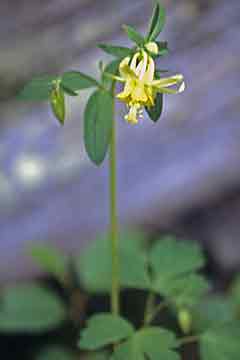 |
Yellow columbine, Aquilegia
flavescens S. Watson (left)
is another montane to alpine species that grows in Idaho’s mountains,
although it is less common than the Sitka columbine. It is easily identified
by its soft yellow sepals ranging at times to a pinkish color. It is closely
related to Aquilegia formosa and the two species may form hybrids.
All gradations of color between the vivid red and yellow of the former plant,
and the overall soft yellow of this one are seen from time to time.
Blue columbine, Aquilegia coerulea E.
James (right), is the Colorado state flower. Five varieties
are recognized. The blue-petaled form, var. coerulea, grows
in the southeast corner of Idaho. A white-petaled variety, var. ochroleuca
Hook., is more widespread ,extending into Central Idaho.
The blue columbine has a large flower with long , nearly straight
spurs that are approximately twice as long as the petals.
Note: most guide books spell this plant's species name
as caerulea. According to botanical rule, the proper spelling is the
one used when a plant is first described. Edward James, a member of the Long
Colorado Expedition, named the plant Aquilegia
coerulea. |
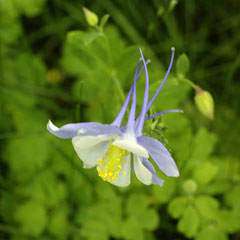 |
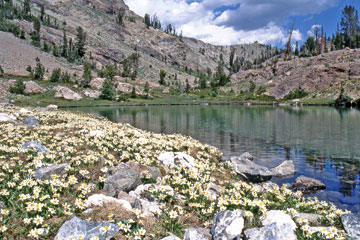 |
White marsh marigold, Caltha leptosepala
DC. (left, right) is an early blooming subalpine
to alpine plant that often grows in great numbers in wet mountain meadows,
and on the banks of the seasonal ponds that form as snow melts. Its deep
green leaves are an elongated heart shape. One to several stems each bear
a showy white flower with a bright yellow center. Its “petals”
are actually petaliform sepals that are sometimes tinged with blue.
Caltha is a Latin word used for a yellow marigold; leptosepala,
means “slender sepals.” |
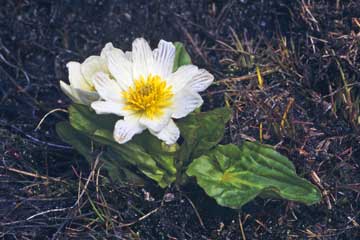 |
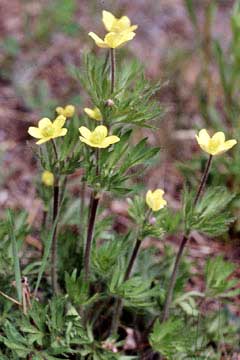 |
Anemones (windflowers, thimbleweeds), Anemone
spp
Some anemones resemble other species in the buttercup family (e.g.
Trollius, Caltha). They may be distinguished by a rosette
of leaves (bracts) on the stem below the flower--a feature of anemones in
general.
Cliff anemone, Anemone multifida
Poir. (left, right), grows on moist ground,
from mid-elevations to alpine tundra. The name, multifida, means
“much divided” referring to its deeply divided leaves. The flowers
are “apetalous,” i.e, the “petals”—usually five
or six—are actually petal-like sepals. Cliff anemones vary greatly in
color, from off-white, through ochroleucous (pale yellow) to deep red, bluish,
or even purple. Given the amount of variation, it is not surprising to learn
that a half dozen varieties are recognized. |
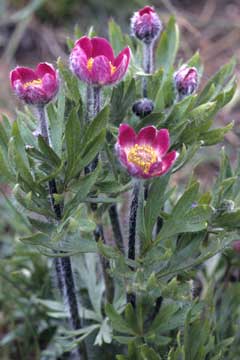 |
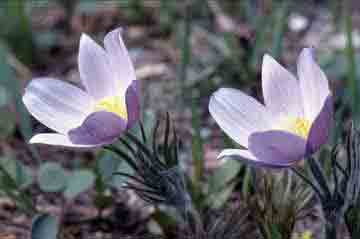 |
American pasqueflower, Anemone
patens L. var. multifida Pritz.
(left) is a lovely plant with large flowers and sepals
that range in color from light blue to deep purple. Deeply incised leaves
are characteristic and distinguish this plant from the similar western
pasqueflower, Anemone occidentalis S. Wats., whose leaves are less
dissected; it too grows in Idaho. “Pasqueflower” has long been
used for a European anemone. John Gerard (1545-1612) in his Herbal
of 1597 wrote, “They flower for the most part about Easter, which hath
mooved me to name it Pasque flower, or Easter flower.”
Small-flowered anemone, Anemone
parviflora Michx.
(right) is usually found growing close to water, in moist
meadows and on streambanks at subalpine elevations. Each plant bears a single
flower made up of petaloid sepals. In the center yellow stamens surround
a spherical head made up of green achenes (fruiting bodies). Anemone
from the Greek is said to mean “daughter of the wind,” explaining
why anemones are also known as “windflowers.” Another common name,
“thimble-weed,” reflects the appearance of the fruiting head.
|
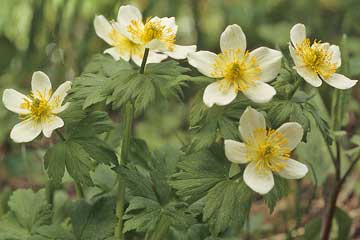 |
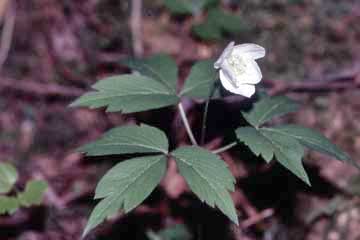 |
Piper’s anemone, Anemone
piperi Britton ex Rydb., is common
in the mountains of north-central Idaho. The plant is characterized by three
compound leaves below a single, delicate white flower. It prefers the moist
ground of shaded forests. Meriwether Lewis collected this—then
unnamed—anemone near the Clearwater River on June 15, 1806. Frederick
Pursh who classified the expedition’s material dropped the ball; apparently
he concluded that Lewis’s specimen was the same plant as an eastern
anemone, and did not include it with other expedition specimens in his
Flora of 1813. |














